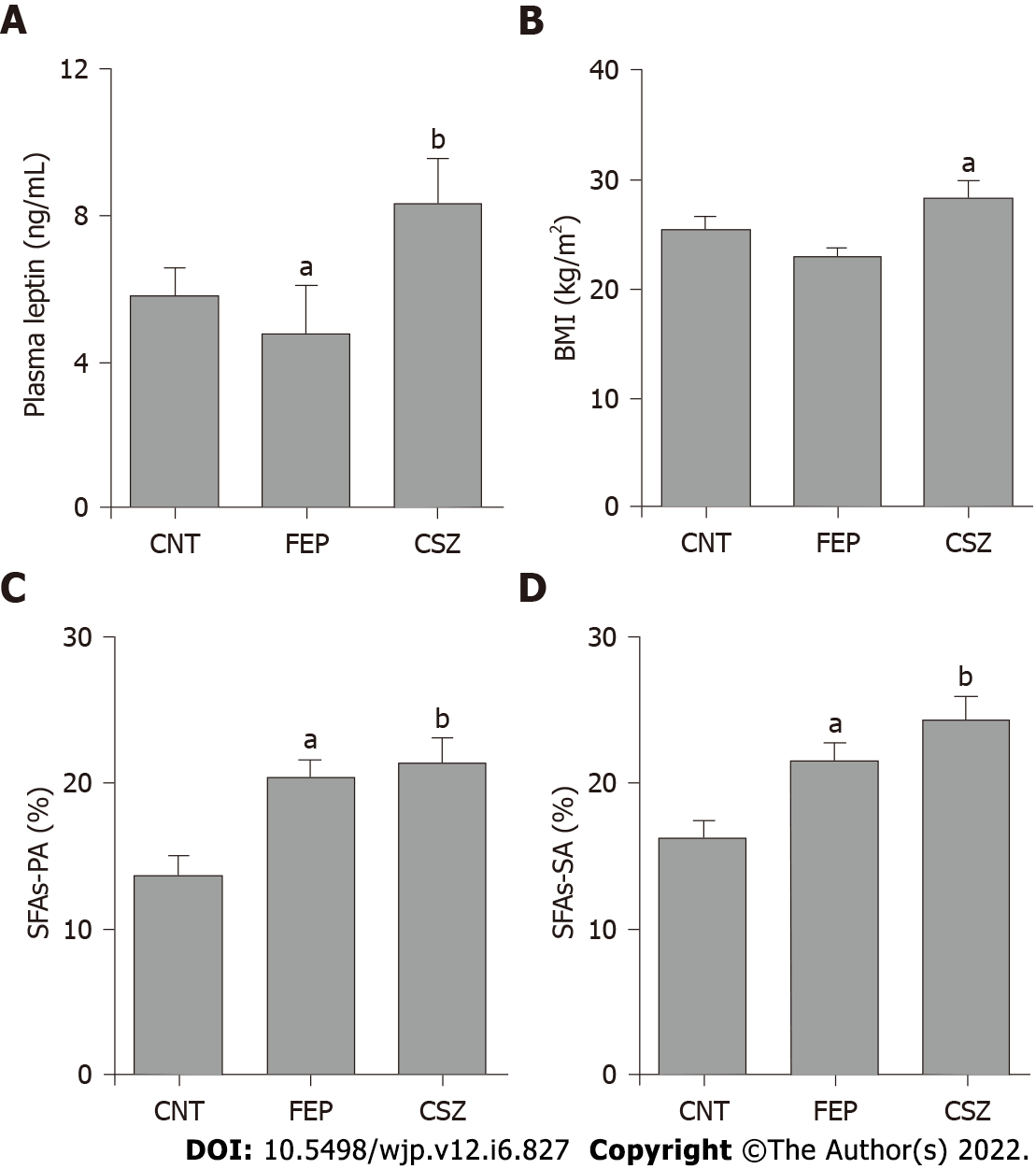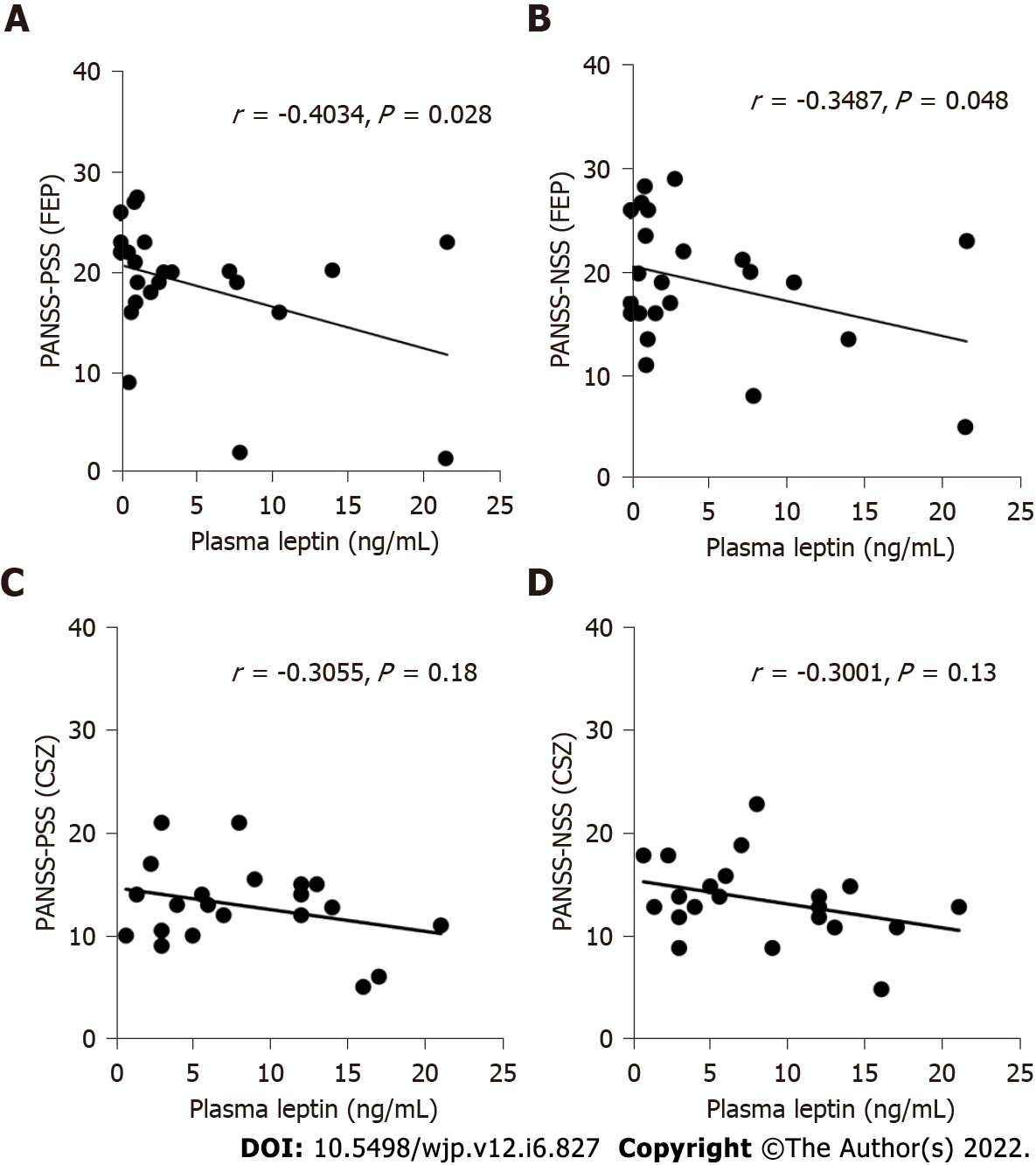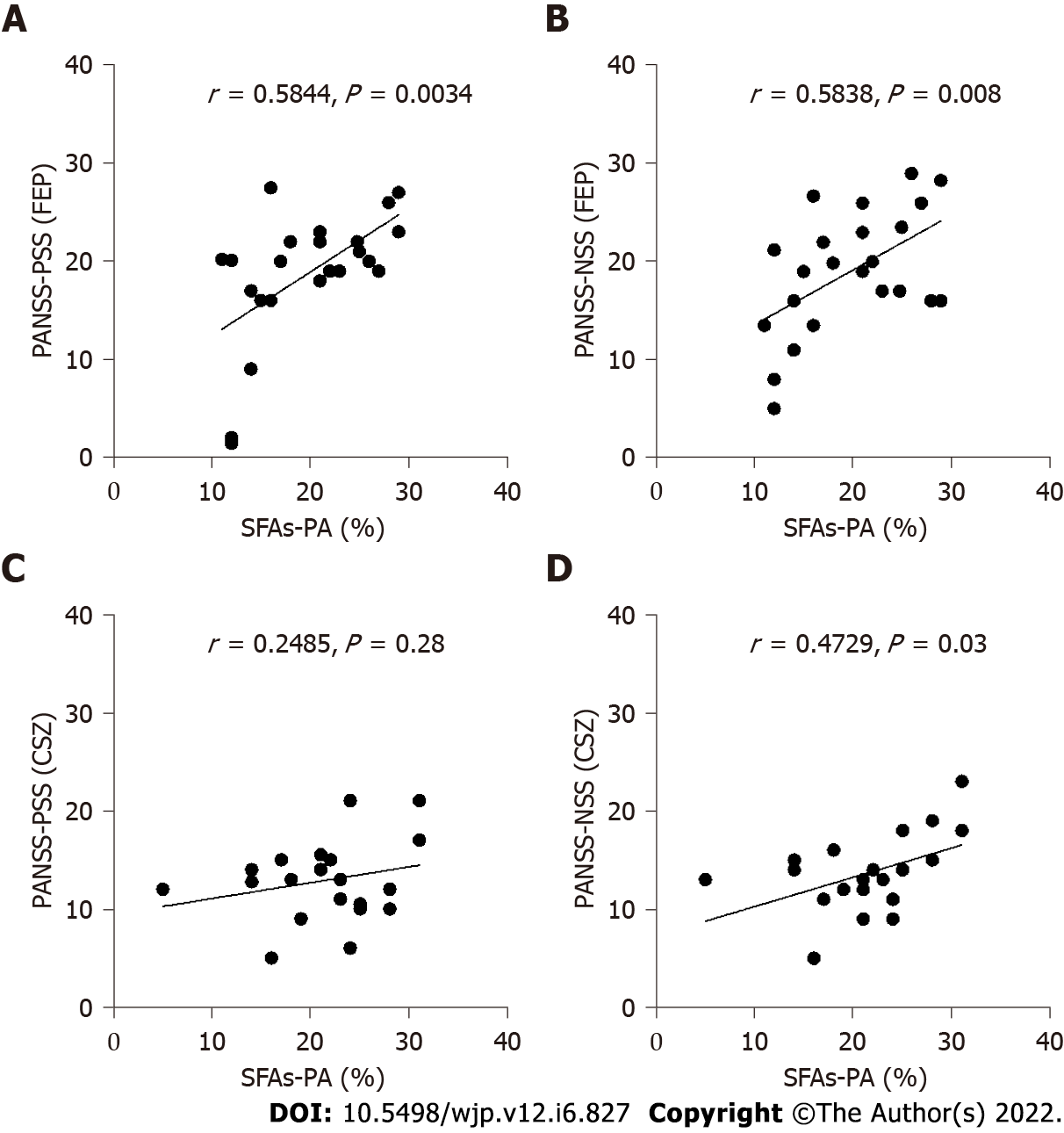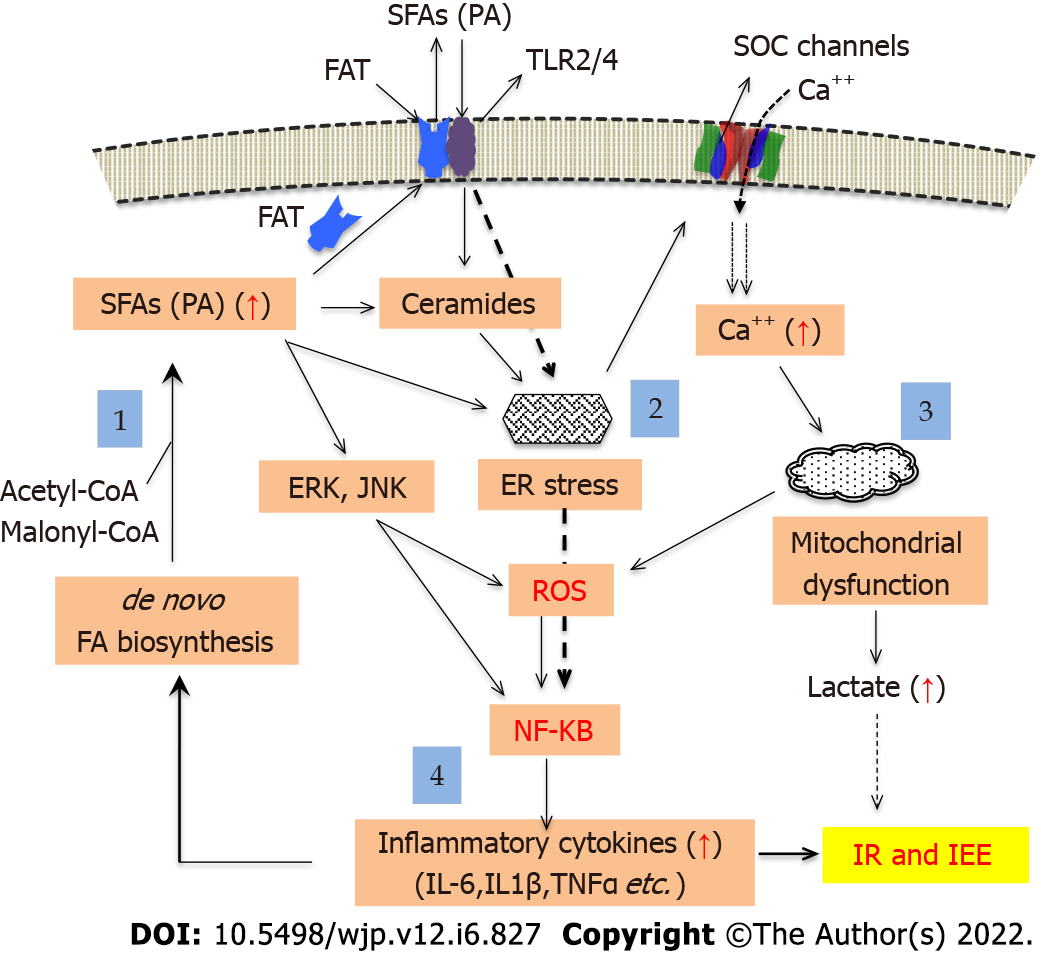Copyright
©The Author(s) 2022.
World J Psychiatry. Jun 19, 2022; 12(6): 827-842
Published online Jun 19, 2022. doi: 10.5498/wjp.v12.i6.827
Published online Jun 19, 2022. doi: 10.5498/wjp.v12.i6.827
Figure 1 Statistical analyses of plasma leptin, body mass index, erythrocyte membrane saturated fatty acids in healthy control subjects, first-episode psychosis and chronic schizophrenia patients.
A: Average plasma leptin (Figure 1A) in first-episode psychosis (FEP) patients (4.77 ± 1.35 ng/mL) was significantly (P = 0.028) lower than healthy control (CNT) subjects (5.79 ± 0.80 ng/mL). In chronic schizophrenia (CSZ) patients, plasma leptin (8.33 ± 1.25 ng/mL) was significantly higher than FEP patients (P = 0.006); B: The average body mass index (BMI) value of FEP patients (23.21 ± 2.14) was statistically similar to the BMI value of CNT subjects (25.10 ± 2.61, P = 0.144). The average BMI value of clozapine treated CSZ patients (29.86 ± 3.60) was significantly (P = 0.012) higher than FEP patients; C and D: Erythrocyte membrane palmitic acid and stearic acid, respectively were significantly (P < 0.005) higher in both FEP and CSZ patients compared to the CNT subjects. CNT: Healthy control; FEP: First-episode psychosis; CSZ: Chronic schizophrenia; BMI: Body mass index; SFAs: Saturated fatty acids; PA: Palmitic acid; SA: Stearic acid. aP < 0.05 and bP < 0.01.
Figure 2 Association of plasma leptin with clinical symptom (positive and negative syndrome scale) scores.
A and B: In first-episode psychosis patients, plasma leptin showed negative correlation with both positive symptom score (PANSS-PSS) (r = −0.4034, P = 0.028) and negative symptom score (PANSS-NSS) (r = −0.3487, P = 0.05); C and D: In chronic schizophrenia patients, no significant negative correlation was observed between plasma leptin and either PANSS-PSS (r = −0.3055, P = 0.18) or PANSS-NSS (r = −0.3001; P = 0.13). PANSS-PSS: Positive and negative syndrome scale-positive symptom score; PANSS-NSS: Positive and negative syndrome scale-negative symptom score; FEP: First-episode psychosis; CSZ: Chronic schizophrenia.
Figure 3 Association of erythrocyte membrane saturated fatty acids-palmitic acid with clinical symptoms (positive and negative syndrome scale) scores.
A and B: In first-episode psychosis patients, erythrocyte saturated fatty acids (SFAs)-palmitic acid (PA) showed positive correlation with both positive symptom score (PANSS-PSS) (A, r = 0.5844, P = 0.0034) and negative symptom score (PANSS-NSS) (B, r = 0.5381, P = 0.008); C and D: In chronic schizophrenia patients, erythrocyte SFAs-PA showed positive correlation with PANSS-NSS (D, r = 0.4729; P = 0.031), but it was not significant in case of PANSS-PSS (C, r = 0.2485, P = 0.28). Similar results were obtained with erythrocyte membrane stearic acid (data not shown). PANSS-PSS: Positive and negative syndrome scale-positive symptom score; PANSS-NSS: Positive and negative syndrome scale-negative symptom score; FEP: First-episode psychosis; CSZ: Chronic schizophrenia; SFAs: Saturated fatty acids; PA: Palmitic acid.
Figure 4 Association of plasma leptin with erythrocyte saturated fatty acids and body mass index.
A-D: In first-episode psychosis patients, plasma leptin showed negative correlation with saturated fatty acids (SFAs)-palmitic acid (PA) (A, r = −0.4335, P = 0.0194) but not with body mass index (BMI) (B, r = 0.2169, P = 0.3206), whereas, in chronic schizophrenia patients, plasma leptin showed positive correlation with BMI (C, r = 0.4135, P = 0.0152) but not with erythrocyte SFAs-PA (D, r = 0.3331, P = 0.1401). FEP: First-episode psychosis; CSZ: Chronic schizophrenia; BMI: Body mass index; SFAs: Saturated fatty acids; PA: Palmitic acid.
Figure 5 Mechanisms underlying saturated fatty acids-(palmitic acid)-induced insulin resistance and impaired energy expenditure.
Saturated fatty acids (SFAs) are synthesized de novo in the cytoplasm from acetyl-CoA and malonyl-CoA (light blue box 1), and are transported by fatty acid transporter proteins from intracellular space to the membrane and to the extra cellular space. Excess SFAs-palmitic acid (PA) can also be converted into ceramides, which together with PA can induce endoplasmic reticulum (ER) stress via depletion of stored calcium (light blue box 2). ER stress leads to increased calcium influx via plasma membrane-bound store operated calcium channels, resulting into the elevation of cytoplasmic and mitochondrial calcium and production of reactive oxygen species (ROS) as a result of mitochondrial dysfunction (light blue box 3). Both PA and ceramides can also activate plasma membrane TLR2/4 receptor resulting in the activation of MAPK/ERK and JNK pathways. Activation of these pathways leads to the production of ROS and NF-κB activation (light blue box 4), which enhances expression of inflammatory cytokine genes resulting into generation of inflammatory response and development of insulin resistance (IR) and impaired energy expenditure (IEE). SFA-induced mitochondrial dysfunction also stimulates anaerobic glycolysis leading to enhanced production of lactate, which also contributes in the development of IR and IEE. SFAs: Saturated fatty acids; PA: Palmitic acid; SOC: Store operated calcium; ROS: Reactive oxygen species; ER: Endoplasmic reticulum; IR: Insulin resistance; IEE: Impaired energy expenditure.
- Citation: Khan MM. Disrupted leptin-fatty acid biosynthesis is an early manifestation of metabolic abnormalities in schizophrenia. World J Psychiatry 2022; 12(6): 827-842
- URL: https://www.wjgnet.com/2220-3206/full/v12/i6/827.htm
- DOI: https://dx.doi.org/10.5498/wjp.v12.i6.827













